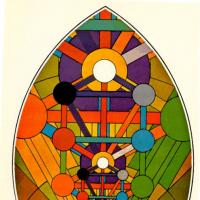Viestejä: 10
Kieli: English
kristosferos (Näytä profiilli) 10. toukokuuta 2010 11.17.57
'A rider goes by, but his dust of passing hangs in the air.'
Rajdanto pasas, sed sia polvo de pasanta ŝvebas en la aeron.
'Look down this road through the particles into infinity.'
Rigardas desupre ĉi tiu vojo tra la partikloj en senfineco.
tommjames (Näytä profiilli) 10. toukokuuta 2010 11.34.26
kristosferos:Rajdanto pasas, sed sia polvo de pasanta ŝvebas en la aeron.First off you can't use sia that way because sia always refers back to the subject, and thus cannot be the subject. You should therefore say "lia".
Also you shouldn't use "pasanta" for "passing" because the sense is substantive rather than adjectivial. You should instead say "la polvo de lia pasado". Also you should leave off the "n" from "aeron", since you're not looking to show direction of movement.
kristosferos:Rigardas desupre ĉi tiu vojo tra la partikloj en senfineco.For "look down this road" I would say "rigardu laŭ ĉi tiu vojo". For "into infinity" you should use the "n" ending on whatever word you choose to represent infinity, to show the direction of your looking.
ceigered (Näytä profiilli) 11. toukokuuta 2010 3.52.49
tommjames:I was always under the impression that s- style words can relate back to the subject meaning-wise even if it isn't isn't the grammatical subject of one phrase. That's what I thought, anyway, because otherwise then "sia" becomes fairly redundant (as si I thought was meant to differentiate between the "first him/her" and any other "him/hers"). However I thought that you wouldn't overuse it not because it was grammatically incorrect but because it was bad written style if you overused "si-".kristosferos:Rajdanto pasas, sed sia polvo de pasanta ŝvebas en la aeron.First off you can't use sia that way because sia always refers back to the subject, and thus cannot be the subject. You should therefore say "lia".
That may just be a habit I picked up when I was actively learning Swedish though - I remember reading that "sig" was used to refer to the original "him/her" that you were talking about, so you could say things like "the man rode the boys bike" as "Li rajdis lian biciklon".
erinja (Näytä profiilli) 11. toukokuuta 2010 16.13.22
* si and sia always refer to the subject of a sentence - the grammatical subject
* si and sia can never BE the subject of a sentence, or the subject of a subclause, or any kind of grammatical subject whatsoever
Every language does reflexivity differently. It is a mistake to say "French does it this way" or "Swedish does it that way", because however French and Swedish do it, that has no bearing whatsoever on how Esperanto does it.
ceigered (Näytä profiilli) 12. toukokuuta 2010 5.11.36
It is a mistake to say "French does it this way" or "Swedish does it that way", because however French and Swedish do it, that has no bearing whatsoever on how Esperanto does it.Well, I was assuming that Zamenhoff would have been inspired from somewhere in the European languages

That confusion aside, what's a good way to differentiate between two different 'hes' or 'shes' at the start of a sentence (the grammatical subject)?
darkweasel (Näytä profiilli) 12. toukokuuta 2010 5.22.54
ceigered:Just as in any other language: say explicitly whom you're talking about, for example by stating their name.
That confusion aside, what's a good way to differentiate between two different 'hes' or 'shes' at the start of a sentence (the grammatical subject)?
ceigered (Näytä profiilli) 12. toukokuuta 2010 5.34.40
darkweasel:Dankonceigered:Just as in any other language: say explicitly whom you're talking about, for example by stating their name.
That confusion aside, what's a good way to differentiate between two different 'hes' or 'shes' at the start of a sentence (the grammatical subject)?
 - so it's not a really big issue then I guess not being able to use si(a) as a subject?
- so it's not a really big issue then I guess not being able to use si(a) as a subject? darkweasel (Näytä profiilli) 12. toukokuuta 2010 5.43.01
ceigered:Not really. German and English don't even have something equivalent to sia (they just use the equivalents of lia, ŝia, ĝia) and they get along fine.darkweasel:Dankonceigered:Just as in any other language: say explicitly whom you're talking about, for example by stating their name.
That confusion aside, what's a good way to differentiate between two different 'hes' or 'shes' at the start of a sentence (the grammatical subject)?- so it's not a really big issue then I guess not being able to use si(a) as a subject?
erinja (Näytä profiilli) 12. toukokuuta 2010 20.35.43
ceigered:Well, I was assuming that Zamenhoff would have been inspired from somewhere in the European languagesI'm sure he was, but considering that each European language has different rules, how can you possibly guess which one he may have been inspired by?
The only thing to do in cases of uncertainty is to look in a reputable grammar reference such as PMEG or PAG, and learn how it's done. Looking to other foreign languages is liable only to add confusion.
Even if your Esperanto level is not very high, in most cases, you don't need a high level of grammatical understanding to understand a document like PMEG. Technical reference guides are written in a relatively straightforward manner and are therefore easier to understand than works of artsy fartsy literature that use a lot of rare roots and unusual word orders.
darkweasel (Näytä profiilli) 12. toukokuuta 2010 20.50.49
erinja:which one he may have been inspired by?2010-05-12 22:43:11 <darkweasel> bone - en la angla lernu!-a forumo okazas diskuteto pri tio, de kie zamenhof prenis la regulojn por "sia"..
2010-05-12 22:43:31 <darkweasel> ŝajne ne de slavaj lingvoj
2010-05-12 22:44:08 <Gyuri> de la latina?
2010-05-12 22:45:01 <tommjames> li probable rimarkis ke estas tute senutile, ke si rilatu al io alia ol nur la tria persono
2010-05-12 22:45:22 <darkweasel> Gyuri: hmm eble, tio ja sencas..
2010-05-12 22:45:54 <darkweasel> jes, verŝajne li kopiis latinon




